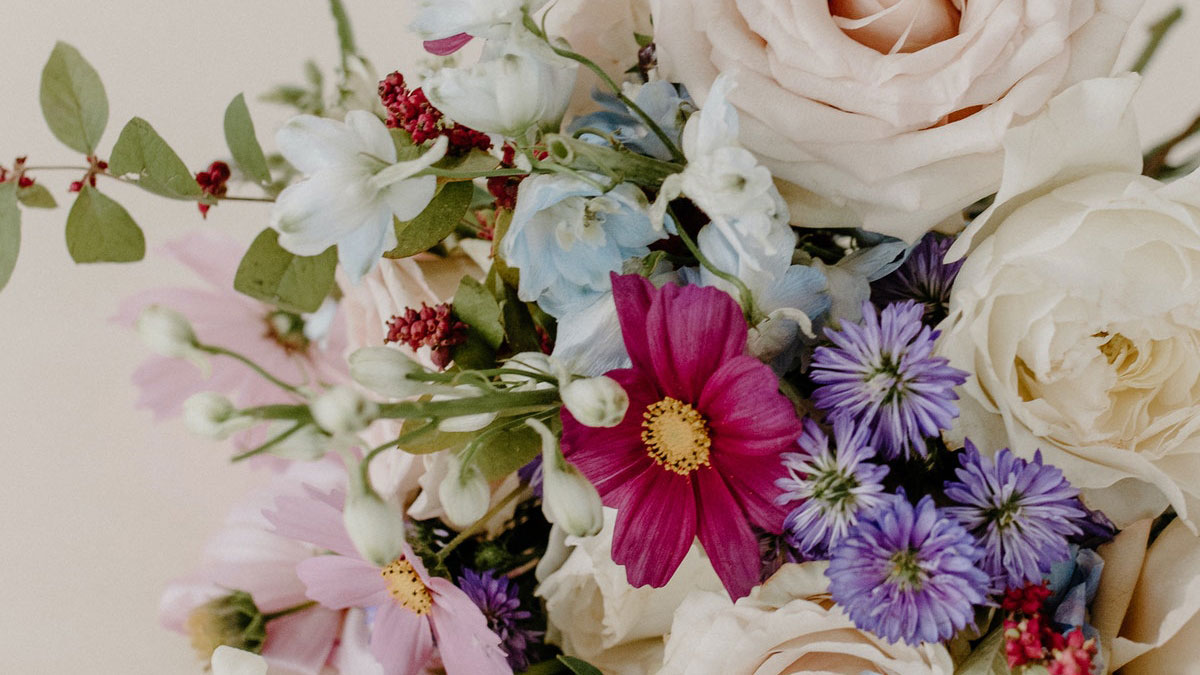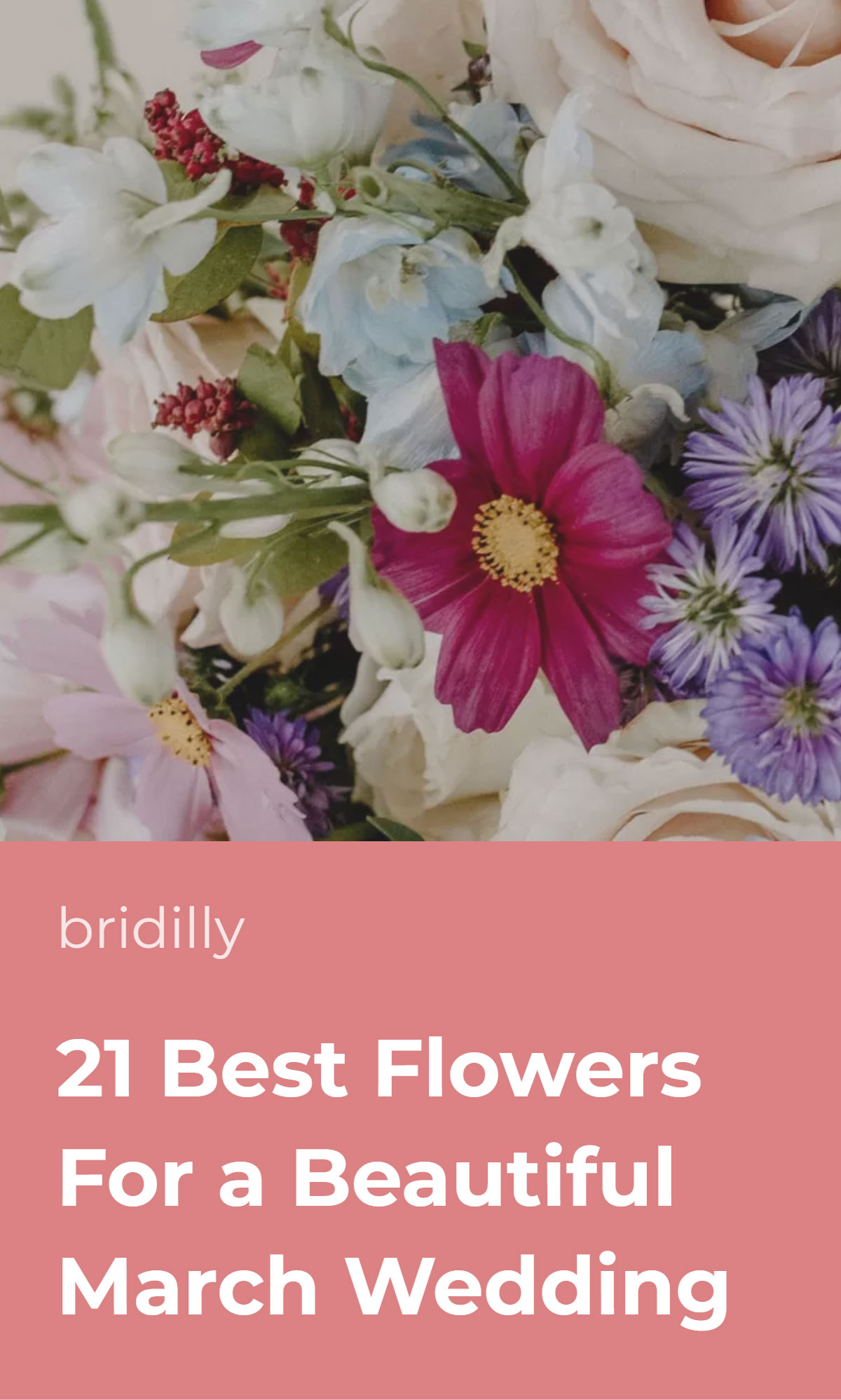Spring is arguably the best time to get married, and seasonal March wedding flowers are one of the reasons.
Some of the most beautiful, delicate florals are spring-bloomers, including lily of the valley, irises, daffodils, and hyacinths.
Nowadays, many flower varieties are available year-round. However, seasonal blooms tend to be fresher and more cost-effective.
Furthermore, spring flowers perfectly match the season’s unique appeal, and floral arrangements are an integral part of your wedding atmosphere.
Choose flowers based on your wedding style, color theme, and location. For instance, wildflowers are best for rustic weddings while exotic for a modern style.
Table of Contents [show]
1. Magnolia
Magnolia trees boast pretty pink, purple, cream, and white blooms with balmy sweet fragrance and large, dark green leaves.
Magnolia flowers are an excellent choice for bridal bouquets and venue décor, and a couple of magnolia leaves can instantly liven up a minimalistic floral arrangement.
A mono magnolia bridal bouquet is impeccably chic, but if you prefer more elaborate arrangements, consider combinations with peonies, anemones, and lilies. Smaller magnolia blooms make stunning boutonnieres and hairpieces.
2. Lily of the Valley
Delicate blooms with a beautiful name, lily of the valley, are among the most dainty spring wedding flowers. A small mono bouquet of these tiny blooms with a sweet yet fresh fragrance is ideal for modest brides.
However, the lily of the valley also serves as a great filler flower in spring wedding bouquets. It looks beautiful paired with sweet peas, hyacinths, freesia, and any white garden blooms.
3. Freesia
Freesias are elegant spring flowers with a delicate baby powder-like fragrance. Freesias come in a range of colors, including white, cream, yellow, orange, red, pink, and purple.
Freesia is a popular wedding flower due to its versatility and wide applications – it’s suitable for bouquets, boutonnieres, hairpieces, and various venue décor.
Furthermore, freesias pair well with most seasonal flowers, including lisianthus, tulips, daffodils, and lily of the valley.
4. Hydrangea
Dreamy hydrangeas are endlessly romantic, ideal for a bohemian or whimsical spring bride. They can add texture and volume to any wedding bouquet and come in a range of pretty pastel shades.
Mono hydrangea bridal bouquets are increasingly popular, but they may appear too spherical. Unless that’s the look you’re aiming for, consider pairing hydrangeas with anemones, gypsophila, lily of the valley, or roses.
5. Foxglove
Foxgloves are unusual spring wedding flowers with a long stem covered in clustered bell-shaped blooms. This unique flower comes in many colors, including red, pink, purple, and yellow, but white is the most common choice for weddings.
Foxgloves are rarely used in mono bouquets, but they can add a modern twist to any traditional floral arrangement. Furthermore, foxgloves are ideal for venue décor – they look stylish in a tall vase or adorning ceremony arch.
6. Scabiosa
Scabiosa has an unusual ruffly texture and an incredibly wide selection of colors, from white and pastel to dark purple. It’s ideal for rustic and bohemian weddings, adding an edge to delicate floral arrangements.
Scabiosa looks great with nearly all spring flowers, from traditional roses and tulips to creative two-toned carnations and foxgloves.
7. Daffodil
March air may still be cold, but the sun already shines generously. Embrace the spring feeling with a sunny yellow daffodil bridal bouquet. Alternatively, consider orange, pink, white, and two-toned varieties.
Apart from bouquets, daffodils are ideal for centerpieces, boutonnieres, and other small accessories. They have a long vase life and are cost-effective.
Daffodils look the best with freesias, tulips, irises, hyacinths, and filler flowers like lily of the valley or crocus.
8. Anemone
You can recognize an anemone by its large black center and delicate round petals. These gorgeous blooms come in red, pink, purple, blue, and white colors and work well for bridal bouquets and venue décor.
White anemones are the most popular choice for weddings – they are ideal for dreamy arrangements with an edge. A combination of anemones, peonies, and hyacinths looks endlessly romantic and creative.
Meanwhile, a bouquet of dark burgundy and plum anemones with chrysanthemums, carnations, and proteas is a stylish option for dramatic brides.
9. Hyacinth
Hyacinths have unusual, clustered blooms resembling tiny grapes and intoxicating sweet fragrance. While the most common hyacinth color is blue, this spring flower also comes in white, cream, pink, peach, wine red, and purple.
Hyacinths look beautiful with most seasonal flowers, including sweet peas, lilac, anemones, hydrangeas, and peonies. Smaller hyacinth stems can serve as boutonnieres.
10. Peony
Peonies have large, rounded blooms with dozens of delicate petals and come in a rainbow of colors, from white and peach to dark red and purple. Some peonies are two-toned, combining pretty pastel shades.
Peonies are ideal for feminine, romantic brides and can add texture to any bouquet. They pair well with roses, ranunculus, carnations, sweet peas, hydrangeas, and other garden blooms.
11. Sweet Peas
Sweet peas are among the most dainty spring blooms, featuring soft petals and a delicate fragrance. Sweet peas come in all blue, pink, purple, and white shades.
Note that these flowers have a relatively short vase life, so if you opt for a sweet pea bridal bouquet, make sure it’s made on the day of.
Sweet peas go well with many garden flowers, including freesias, lisianthus, and irises, adding an aerial, whimsical touch to bouquets.
12. Tulip
Tulips are the ultimate spring flowers. Even though some tulips bloom in winter and summer, spring is the prime time for the prettiest tulip varieties.
Classic single early tulips, fringed parrot tulips, or voluminous double tulips – each of these beautiful types come in a plethora of colors, including two-toned and nearly black.
The best thing about tulips is that they are suitable for any application, from bridal bouquets to boutonnieres, and have a relatively long vase life.
13. Lilac
Lilac is typically light to dark purple, but some varieties are white, blush, or magenta. Lilac has a pleasant sweety-fresh fragrance and looks beyond gorgeous in mono arrangements or adorning a ceremony arch.
If you don’t like mono bridal bouquets, consider combinations with peonies, carnations, and sweet peas. Add small blooms like lily of the valley or gypsophila, and a romantic wedding bouquet is ready.
14. Chrysanthemum
Chrysanthemums are available year-round and have endless varieties. Some chrysanthemums have rounded petals and a globe-like shape, resembling pompoms. Others have long, thin petals that look like spider legs.
Then, there are chrysanthemums with a single petal row, resembling daisies, and two-toned varieties. In other words, these garden flowers come in all shapes, sizes, and colors. Due to such a wide selection, chrysanthemums are highly versatile.
15. Iris
Irises are typically blueish-purple, but some are pale blue, mauve, pink, white, yellow, and even burnt orange. Some varieties feature creative color combinations – for instance, burgundy and blue, orange and black, or purple and yellow.
These extraordinary blooms work well for boutonnieres, hairpieces, cake and venue décor, and bridal bouquets.
Irises look impeccably elegant with lisianthus, freesias, crocuses, lily of the valley, hyacinths, and daffodils. However, an iris-only bridal bouquet is equally stylish and will undoubtedly draw attention.
16. Calla Lily
Calla lilies are the most popular exotic wedding flowers year-round. These unique trumpet-shaped blooms come in a myriad of hues, including pink, nearly black, and two-toned, but white is the most common wedding color.
Minimalism lovers may consider a mono calla lily bridal bouquet or combinations with filler flowers like lily of the valley and gypsophila.
If you prefer more intricate floral arrangements, combine calla lilies with tiger lilies, orchids, roses, anemones, or freesias. Single calla lily blooms are ideal for boutonnieres, hairpieces, and table décor.
17. Baby’s Breath
Baby’s breath scientific name is gypsophila. This filler flower has a myriad of tiny white blooms and resembles a snowy cloud. Sometimes, florists dye it in vibrant colors.
Baby’s breath goes well with all wild, garden, and exotic flowers – it instantly makes any bouquet look aerial and dreamy. Mono gypsophila bouquets are ideal for venue decoration.
18. Carnation
Some brides avoid carnations, thinking they’re too cheap for such a big day. While carnations indeed are cost-effective, they are no less gorgeous than some expensive blooms and have a long vase life.
Carnations are suitable for venue decor, bridal bouquets, and boutonnieres. The color selection is endless, from white to nearly black. Some varieties boast pretty contrasting shade combinations, like red and white or blue and brown.
19. Cornflower
The most common cornflower color is azure blue, but some blooms are pink, mauve, or white. Cornflower is a popular rustic wedding flower suitable for bouquets, boutonnieres, flower crowns, and venue décor.
Cornflowers look the best with wildflowers, like sunflowers, gypsophila, lily of the valley, forget-me-not, and yarrow.
20. Rose
Roses are undoubtedly the most common wedding blooms – frankly, it’s the most popular flower variety overall. Roses are available year-round, come in a rainbow of colors, have a long vase life, and are simply beautiful.
Furthermore, roses are versatile. They work well in centerpieces, boutonnieres, hairpieces, and bridal bouquets. Depending on the variety, roses can fit any wedding style, from tropical to rustic.
21. Forsythia
Strictly speaking, forsythia isn’t a flower. It’s a tree with brown branches boasting a myriad of sunny yellow blooms in spring. Forsythia is an excellent way to incorporate yellow accents into your venue decor.
Forsythia can also serve as a bouquet filler. It looks the best with white, blue, and yellow rustic flowers.
















No Comments Add one
Leave a Comment